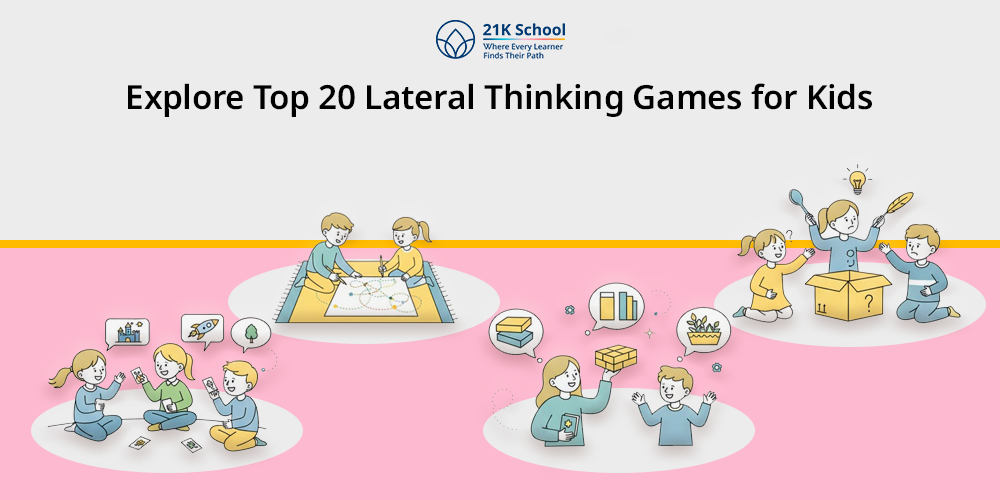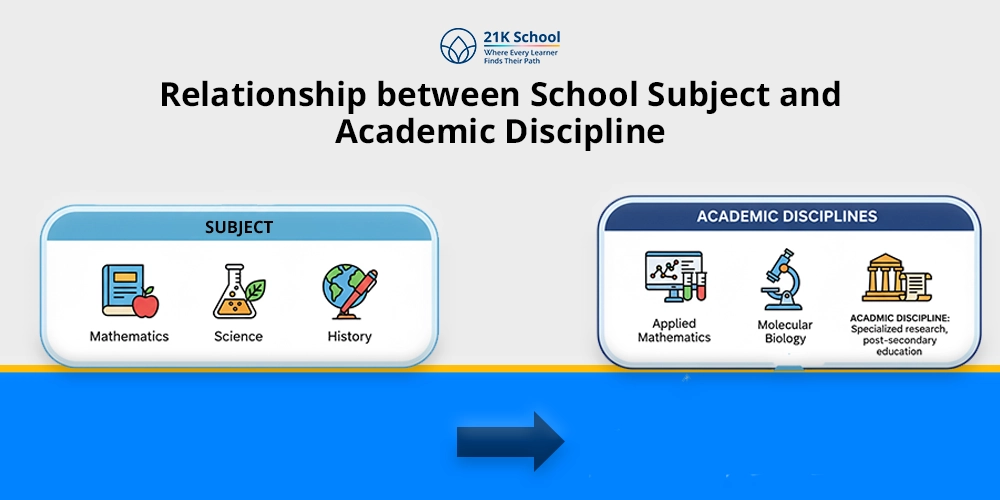
In the 21st century education is no longer real life on traditional learning approaches. Instead of memorising and rote learning kids are now encouraged to think out of the box solutions.
To enhance such as problem solving skills and sharing innovative ideas for various challenges, powerful techniques like lateral thinking games for kids are useful.
Lateral thinking is a popular term focused on problem-solving in an innovative way instead of traditional methods.
The below mentioned information is effective to strengthen creativity, reasoning and confidence in decision-making. Here, we will discover top 20 lateral thinking games for kids for future growth.
Table of Contents
- What are Lateral Thinking Games?
- 20 Popular Lateral Thinking Games for Kids
- 1. Puzzle
- 2. Board Games
- 3. Brain Teaser
- 4. Flashcard Memory Game
- 5. Riddles
- 6. The Man in the Bar
- 7. 20 Questions Game
- 8. What Happens Next?
- 9. Odd One Out
- 10. Pattern Hunt
- 11. Story Completion Game
- 12. Dilemma Scenarios
- 13. Mystery Bag Game
- 14. Reverse Thinking
- 15. Logic Grid Puzzles
- 16. Guess the Object
- 17. Escape Room at Home
- 18. Two Truths and a Lie
- 19. Creative “What If” Scenarios
- 20. Heaven and Hell
- Conclusion
What are Lateral Thinking Games?
Lateral thinking games in learning includes various activities like puzzles, riddles, memory games etc which guides learners to think via fresh perspective instead of conventional way.
In a traditional education approach where students apply formulas or logical sequences, lateral thinking games work on critical thinking and problem solving to get innovative solutions.
20 Popular Lateral Thinking Games for Kids
To understand how to implement lateral thinking in kids daily life go through 20 popular games for kids:
1. Puzzle
One of the classic and popular lateral thinking games is “Puzzle”. It includes different forms of activity such as jigsaw puzzles, Sudoku, or crossword puzzles etc.
This game helps learners to find out different ways to solve the pattern and continues trying until it is solved.
2. Board Games
Board games are interactive ways to play with friends as a group where kids strategies how to win and competitors’ mindset to defeat.
It is an effective game that encourages kids to participate, battle with each other and win to build confidence.
Brain teasers are a popular variety of puzzles focusing on engaging learners for healthy brain stimulation.
Some of the key advantages of brain teaser as a lateral thinking activity covers improving mental health and analytical skills development primarily.
4. Flashcard Memory Game
Flash card memory game is one of the famous lateral thinking activities in which picture, number, or word cards are flipped by kids to find the matching cards.
The game is ideal to improve thinking skills, memory power and concentration to pick the right card to win.
5. Riddles
Who doesn’t like amazing riddles having word twists or word play?
These riddles are not only entertaining but come under Short puzzle including wordplay or word twist which needs creative thinking skills and twisted answers.
They are popular as fun and engaging brain games/exercises for kids.
6. The Man in the Bar
The game starts with an individual walking into a bar. Then, asks for a glass of water at the counter.
Later, the bartender points a gun at him and the individual says thanks and walks out.
Do you know why? Because the man had hiccups and the gun helped him by curing.
7. 20 Questions Game
In this game one person thinks of an object and another player asks 20 questions (yes/no) to find out the object name.
The challenge helps them to think of various possibilities, engage them and improve communication skills.
8. What Happens Next?
“What Happens Next?” is a game in which kids take the next step by looking at a picture, video clip, or real-life situation.
For example, if a can walking towards food kids predict whether she will eat or not. It improves their predictive skills, logical thinking and imagination power.
9. Odd One Out
Odd one out with simple twisted answers is an ideal lateral thinking game for kids where they get 4-5 items or pictures of items in which they think critically and choose an odd one out.
For example, items like pineapple, banana, carrot, mango instead of choosing carrot as odd one kid select mango as it contains seed.
10. Pattern Hunt
Pattern hunt is a kind of lateral thinking puzzle game in which kids identify the hidden pattern or criteria.
For example, 2, 4, 8, 16, ? And the answer is 32. But for lateral twists, patterns can be abstract, like spotting repetitions in sounds or colors.
11. Story Completion Game
In this game a facilitator or parents start a story for example, Once upon a time in a village. Later kids continue the story by adding lines.
The activity brings an unexpected ending which creates interest and curiosity. It is ideal for group collaboration and improving creative thinking skills.
12. Dilemma Scenarios
In this lateral thinking game facilitators keep a situation to students for example, what would you do if two people fell from a tree? Who will you save first?
The situation puts students into a dilemma which helps them in future to make the right decision in critical situations.
13. Mystery Bag Game
In mystery bag games kids put their hand in a bag containing a lot of different sized objects and guess the object by their texture.
To make it more lateral, teachers asked them to invent new uses for those objects.
14. Reverse Thinking
In reverse thinking kids flip the question for example, instead of asking how to clean the classroom they are how to mess.
Later reverse the answers into positive solutions. It is an effective way of problem-solving in an unusual manner.
15. Logic Grid Puzzles
Logic grade puzzles are kind of brain teasers in which kids solve complex scenarios with clues. Then kids analyse the possibilities and eliminate based on findings.
16. Guess the Object
Guess the object is a lateral thinking game in which kids are blindfolded and use their senses like touch, smell, or listen to identify.
The process develops sensory awareness and critical thinking skills.
17. Escape Room at Home
Escape room games at home include kids cracking the code via puzzles, riddles or clues. For example solving a math problem to unlock the cabinet.
The game is ideal for groups to improve teamwork, coordination and time management skills.
18. Two Truths and a Lie
Two truths and a lie game means a kid tells three sentences in which 2 sentences are truths and one is a lie.
Another kid using observation, reasoning, and sometimes lateral interpretation to identify the lie. This encourages social interaction and observation.
19. Creative “What If” Scenarios
In this game open ended questions were asked for example, what if animals talk with humans? Or the sun stops rising.
This shocking question activates participation and discussion in conversation which builds communication skills and divergent thinking.
20. Heaven and Hell
Heaven and hell is a group game in which there are two doors, one is heaven and the other is hell where two guards standing one only speaks truth and the other false.
The third kid’s task is to determine the truth and enter the heaven door to be safe. He/she can ask one question to each to identify the right door.
Conclusion
Fun learning lateral thinking games for kids are effective approaches to engaging kids to play and learn at the same time.
Popular games like puzzles, riddles, scenarios, and imaginative play ensures instead of traditional education kids learn with free mind and modern techniques.
Above mentioned top 20 popular lateral thinking games for kids at home and classroom encourage them to nurture skills beyond academic achievement.
It’s time for parents and teachers to ensure kids are in the right and positive learning environment and foster lateral thinking to solve problems.


